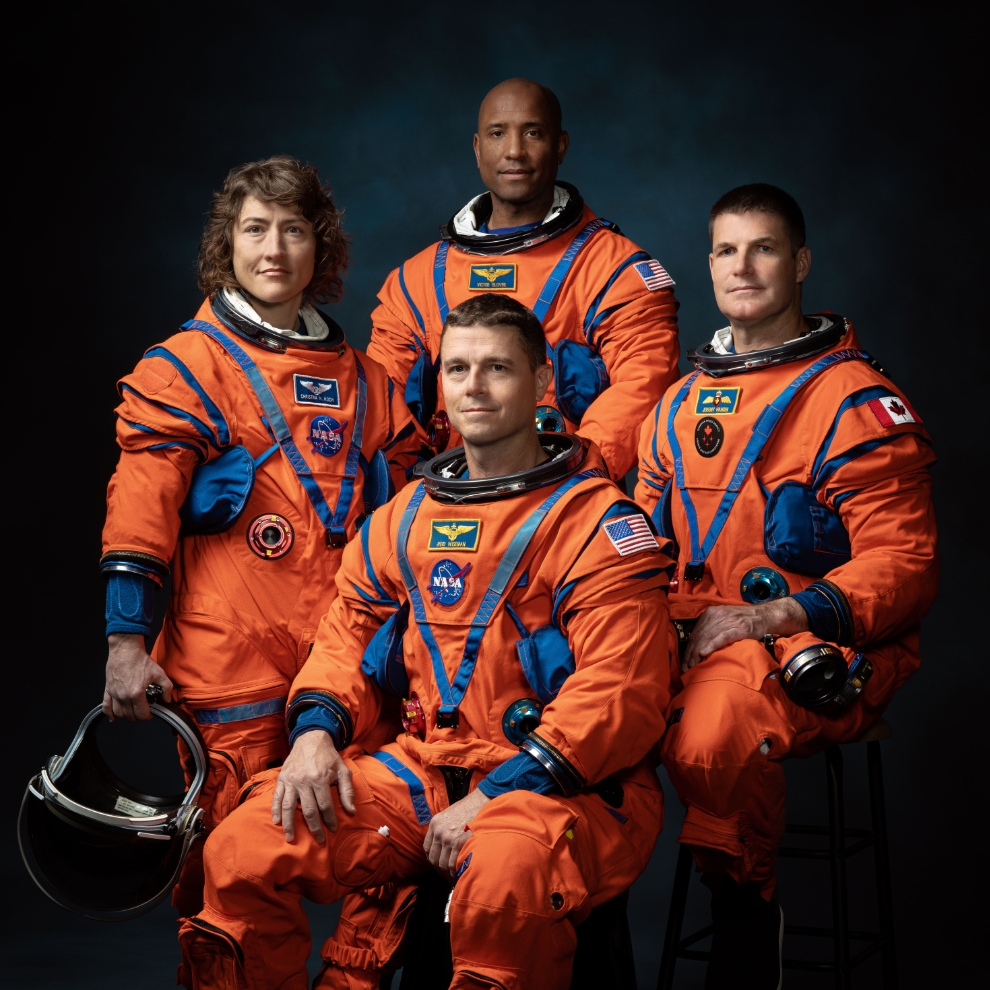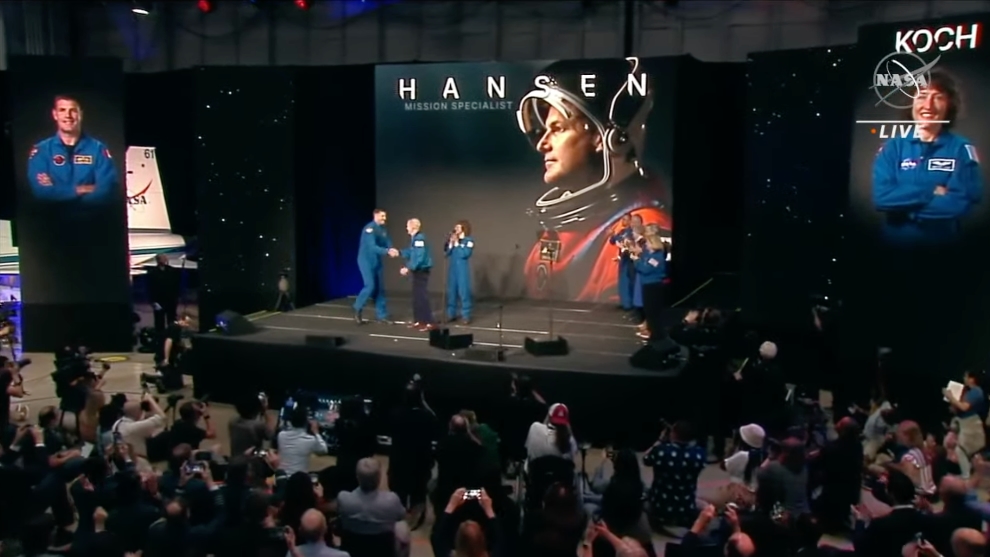Jeremy Hansen’s patience has paid off. After nearly 14 years as a Canadian Space Agency (CSA) astronaut accumulating skills including managing teams like the 2017 astronaut class’ trainers, he will be aboard the Artemis 2 mission that is returning humans to the Moon’s area in November 2024 or so.
Artemis 2 is not a landing mission as the technology to bring humans back to the Moon is under development. That said, its scope is still ambitious – to bring the quartet of crew members around the Moon and assess the Orion’s new life support system, as well as verify the performance of Orion and the Space Launch System rocket more generally following their uncrewed Artemis 1 mission in 2022. The crew includes Commander Reid Wiseman, Pilot Victor Glover, Mission Specialist 1 Christina Hammock Koch, and Mission Specialist 2 Jeremy Hansen.

François-Philippe Champagne, Minister of Innovation, Science and Industry was in attendance and gave a rousing speech in which in part he said “Our partnership which is fueled by bold initiatives and scientific excellence. And most importantly, Canadians could not be more proud to share this moment with our American partners and friends which are here today in Houston. We would not be here today without the friendship and close partnership between our two nations. Because this is more than just about going back to the Moon. This is about investing in the future, this is about possibilities, this is about seizing the opportunities of the space economy from health, food security, to climate change, and much more. So as we embark together on this new space era, let’s seize the moment, let’s be impressive so together that’s inspiring to young people watching us to reach for the stars and become the next generation of scientists engineers and explorers.”
When it came time for Jeremy to say a few words he said “there are two reasons why a Canadian is going to the Moon.” The first is American leadership. He said the United States could be doing this alone but instead “made a very deliberate choice over decades to curate a global team. And that in my definition is true leadership.”
His second reason “is Canada’s can do attitude. For decades now, literally thousands upon thousands of Canadians have risen to that challenge to bring real value to the international partnership with respect to space exploration to bring real solutions, our scientists or engineers, Canadian Space Agency, the Canadian Armed Forces across government, all of our leadership, working together under a vision to take step-by-step, and all of those have added up to this moment where a Canadian is going to the Moon with our international partnership and it is glorious.” He got a rousing ovation for these words. He ended his comments by saying, “so at the end of it all, I am left in awe of being reminded with strong leadership setting big goals with a passion to collaborate and a can do attitude can achieve, and we are going to the Moon together. Let’s go.”
Decades of Work Leading to Today
The CSA opportunity comes courtesy of its contribution of Canadarm3, manufactured by MDA, that will service the planned NASA Gateway space station. Canadarm3 will serve as a keystone of technology development in line with Canadian government priorities. Those priorities include artificial intelligence, and robot performance in harsh and remote environments that can be optimized for rugged situations on Earth.
Canadarm3 also headlines a fast-growing network of Canadian lunar opportunities. Ottawa’s Mission Control (formerly Mission Control Space Services) is expected to test its artificial intelligence technology on the moon for the first time with the United Arab Emirates’ Rashid lunar rover later this month, which will land with the Japanese ispace spacecraft.
The Lunar Accelerator Exploration Program (LEAP) announced by CSA alongside Canadarm3 in 2019 is going to be renewed, we learned days ago in Budget 2023, so we’ll see other Canadian payloads on the Moon soon. The budget also announced a new lunar utility vehicle, and commitments to CSA work like the Space Technology Development Program (STDP) that will also form the backbone of future lunar exploration. Progress is being made, too, on the mini-rover that will land on the Moon in 2026; the science is led by Western University’s Gordon Osinski and it its manufacturing is led by Canadensys.
The CSA is betting big on lunar technology, as its 2023 budget indicates an extreme high in spending associated mostly with Canadarm3 and Moon work. The department plan shows budgetary spending estimates are $476,342,693 on Canada in space along with $61,059,544 in internal services, for a total budget of $537,402,237. Planned spending on the Canada in space segment will drop to $265,605,491 in 2024-25 and $203,502,941 in 2025-6, below 2020-1 levels. Internal services are largely remaining consistent in that time period.
To be sure, Canadian technology has touched the Moon before; the most famous example is the legs of the Northrop Grumman (then Grumman) lunar module that ferried 12 astronauts to the surface across six Apollo missions. Héroux-Devtek (then Devtek) was the Quebec manufacturer who led the legs’ development. But that was nearly two generations ago and seeing more commitment by Canadian companies – and funding to accompany said commitment – will be a welcome development for the industry, which is dependent on exports and resales for business practices.
MDA has already benefitted from Canadarm3, as it is reselling some of the associated technology to Axiom Space for the Houston company’s own work, which will eventually include a set of modules on the International Space Station that can fly free when the orbiting complex retires. (Canada just committed last month to a 2030 extension of ISS, alongside major partners NASA, the European Space Agency and Japan. Russia will likely leave sooner due to the war in Ukraine that has severed most space relationships, but nothing is quite confirmed yet.)
Artemis 2 is certainly an example of playing the long game, considering that the CSA was not an entity – and the Canadian astronaut program, even, not formed under the National Research Council – when the Apollo Moon missions were running between 1968 and 1972. It was not long after that era, however, when the NRC supported the ongoing development of Canadarm, itself based on years of preliminary research.
Canadarm and its successors have been the critical tool in funding about a dozen Canadian professional astronauts on spaceflights through CSA, on NASA missions (although we should not forget the Canadians who have flown to space in other ways, such as on private missions, on Soyuz or as joint American citizens on NASA.)
Canadarm was a crucial part of the space shuttle program and flew on the second mission, STS-2, in November 1981. Twenty years later, of course, Canadarm2 arrived on the ISS on its own critical development path – and not many years after came Dextre, a more multi-limbed assistant. Together these arms have not only fulfilled and exceeded their missions, but have done unexpected things like the spectacular emergency repair spacewalk of STS-120 that fixed a torn solar panel in 2007, knocking ice off a blocked vent of the space shuttle during the STS-41D mission in 1984, and regularly berthing cargo spacecraft to the ISS starting in 2012.
To paraphrase the movie Apollo 13, this wasn’t what the robot arm series was designed to do – but what it can do, sometimes with the help of software upgrades or creative thinking. Canadarm3 will similarly be designed to be flexible, intuitive and adaptable. That is what NASA will be counting on for servicing its Gateway space station, as for most of each year it is forecast to be empty aside from science experiments or technology tools.
There are other things that Artemis 2 will bring to Canada aside from the opportunity furnished to this single CSA astronaut to fly around the Moon, of course. In the months to come, we can expect a series of science experiments to be announced. Technology transfers may also be on board, or perhaps some linkages to the CSA’s ongoing Deep Space Food Challenge or Deep Space Healthcare Challenge whose finalists will be announced in 2024. Further down the road, CSA has a committed Gateway astronaut mission; other lunar missions may follow, too.
In fact, on such a historic day it is worth briefly reflecting upon the Chapman Report of 1967, more properly known as “Upper Atmosphere and Space Programs in Canada” and considered a foundational document of Canadian space.
Its discussion of social implications is admittedly a product of its era. For example, it frames space as a “frontier” (a term borrowed from American “explorers” who stole land from Native American peoples, of course), and the exploration as an “assault.” But other ingredients of that report stand the test of time: the focus on international collaborations, the technological opportunities and the economic risk in investing in early-stage technology, among other things.
Artemis 2 had me looking closely at a couple of sections about the need to establish a central space agency – obviously achieved with CSA, which works closely with more than a dozen other Canadian departments on space and numerous international collaborators – and whether Canada should do launching services. In the current day, we’re restarting commercial launch efforts again with Maritime Launch Services and other companies with early-stage regulatory support from the government. As our country decides where to go next on the momentum of Artemis 2, I’d recommend those interested to take the time to read the nearly 150-page report on SpaceQ’s website. Its findings are still highly relevant – and more current than ever is the need for a national advisory council of some sort focused on space. That’s what Canadian industry has been calling for again in recent years, after the last CSA advisory group’s mandate expired. Perhaps the new focus on space at senior government levels will bring that council into being again. But in any case, the key going forward will be determining how to use Artemis 2 to leverage Canadian space opportunities for even more interesting missions.
 SpaceQ Space news and analysis.
SpaceQ Space news and analysis.






